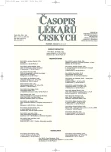The use of modern microneurosurgical methods and state of the art technologies in the treatment of brain tumors and neurovascular diseases
Authors:
Jan Klener; Robert Tomáš; Michal Šetlík
Authors‘ workplace:
Neurochirurgické oddělení Nemocnice Na Homolce, Praha
Published in:
Čas. Lék. čes. 2011; 150: 209-214
Category:
Review Article
Overview
Brain tumors and neurovascular diseases represent the most frequent and serious areas of intracranial neurosurgery. The recent advances in microneurosurgery aim at the complete treatment of the lesions (i.e. radical removal of the tumor, total occlusion of the vascular malformation) while respecting the minimal invasivity for the patient and avoiding risks and morbidity of the surgical procedure. The main tools used in order to accomplish this end are partly meticulous application of recent microneurosurgical principles that enable to treat complicated and deep lesions with minimal retraction and risk of injury to nerves and vascular structures, partly the use of contemporary technologies. Neuronavigation and functional neuronavigation facilitate exact preoperative planning and intraoperative orientation, methods based on fluorescence help to display intravascular blood flow or residual tumor in the operative field and intraoperative magnetic resonance allows exact morphological imaging of the intracranial structures during surgical procedure and increases accuracy of navigation. Electrophysiological monitoring helps to increase the safety of the procedure by continuous tracking of selected brain and nerve functions. Tailored combination and cooperation of aforementioned methods maximizes effect for the uneventful outcome. We present review paper on application of these methods and our experiences in the neurosurgical department Na Homolce hospital and show illustrative cases.
Key words:
microneurosurgery, brain retraction, neuronavigation, intraoperative magnetic resonance.
Sources
1. Yas‚argil MG. A legacy of microneurosurgery: memoirs, lessons, and axioms. Neurosurgery 1999; 45(5): 1025–1092.
2. Hernesniemi J, Niemelä M, Dashti ?, et al. Principles of microneurosurgery for safe and fast surgery. Surg Technol Int 2006; 15: 305–310.
3. Alexander III E, Maciunas RJ. Advanced Surgical Navigation. New York: Theime 1999. 4. Klener J, Urgošík D, Tintěra J. Využití funkční magnetické resonance v neurochirurgii centrální krajiny. Část I. Obecné principy. Čes slov Neurol Neurochir 2003; 5: 329–334.
5. Raabe A, Nakaji P, Beck J, et al. Prospective evaluation of surgical microscope-integrated intraoperative near-infrared indocyanine green videoangiography during aneurysm surgery. J Neurosurg 2005; 103(6): 982–989.
6. Stummer W, Pichlmeier U, Meinel T, Wiestler OD, Zanella F, Reulen HJ. ALA Glioma Study Group Fluorescence-guided surgery with 5-aminolevulinic acid for resection of malignant glioma: a randomised controlled multicentre phase III trial. Lancet Oncol 2006; 7: 392–401.
7. Albayrak B, Samdani AF, Black PM. Intra-operative magnetic resonance imaging in neurosurgery. Acta Neurochir (Wien) 2004; 146(6): 543–556.
8. Stejskal L, et al. Intraoperační stimulační monitorace v neurochirurgii. Praha: Grada Publishing 2006.
Labels
Addictology Allergology and clinical immunology Angiology Audiology Clinical biochemistry Dermatology & STDs Paediatric gastroenterology Paediatric surgery Paediatric cardiology Paediatric neurology Paediatric ENT Paediatric psychiatry Paediatric rheumatology Diabetology Pharmacy Vascular surgery Pain management Dental HygienistArticle was published in
Journal of Czech Physicians

Most read in this issue
- Early repolarisation syndrome and idiopathic ventricular fibrillation
- Temporal lobe epilepsy in adults and possibilities of neurosurgical treatment: the role of magnetic resonance
- Nonconvulsive status epilepticus
- Measurement of exhaled nitric oxide in the diagnosis of asthma
